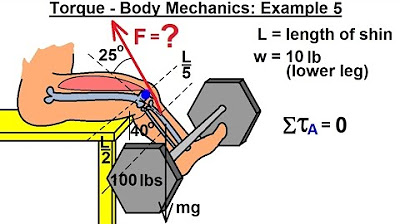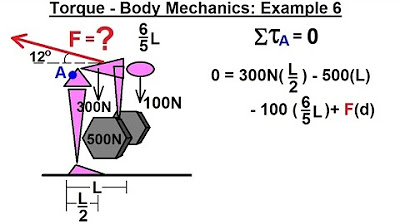Physics 15 Torque (16 of 25) Body Mechanics: Ex. 4, F=? Jaw Muscle
TLDRThe video script explores the physics of jaw mechanics, specifically focusing on torque and the forces involved in biting. It uses the example of a jaw bone, highlighting its curved shape and hinge-like structure near the ears. The script explains that when a muscle pulls up on the jaw bone, it can achieve a bite strength of 100 Newtons, which the food then pushes back against the teeth with an equal force. To calculate the force required by the muscle, the script employs the principle of torques balancing to zero at the hinge point of the jaw. By considering the distances from the force application to the hinge and applying the formula for torque, the script determines that the muscle needs to apply a force of 314 Newtons, which is equivalent to approximately 71 pounds. This demonstrates the significant force that even small jaw muscles can exert, a key factor in the impressive bite strength of some animals like dogs.
Takeaways
- 🦴 The jaw bone has a curved shape and a hinge close to the ears which is crucial for its function.
- 🔄 Torques are used to analyze the physics of the jaw's mechanics, considering the forces and distances involved.
- ⚖️ The bite strength of 100 Newtons is the force with which the food pushes back against the teeth.
- 🧷 The sum of torques about the hinge point (point A) must equal zero for the jaw to be in equilibrium.
- ➗ Positive and negative torques are calculated based on the direction of the force (clockwise or counterclockwise).
- 📐 The perpendicular distance from the line of action of the force to the hinge is 11 centimeters.
- 📏 The muscle's force is applied at a distance of 3.5 centimeters from the hinge, affecting the torque calculation.
- 🔢 The torque problem is solved by setting up an equation that relates the forces and distances.
- 📉 Centimeters cancel out in the final ratio, simplifying the calculation to a matter of distances and Newtons.
- 💪 The muscle needs to apply a force of 314 Newtons to achieve a bite strength of 100 Newtons.
- 🔄 Converting Newtons to pounds, the muscle's force is equivalent to approximately 71 pounds of strength.
- 🐕 Bite strength in dogs varies greatly and is directly related to the strength of the jaw muscle and the torque it can generate.
Q & A
What is the subject of the video script?
-The video script discusses the physics of torques as they relate to the mechanics of a jaw bone, specifically in terms of bite strength.
What is the significance of the hinge point in the jaw bone?
-The hinge point is significant because it is the pivot around which the jaw bone rotates, and it is where the sum of torques must equal zero for the system to be in equilibrium.
How is bite strength related to the force exerted by the muscle?
-Bite strength is directly related to the force exerted by the muscle pulling up on the jaw bone. The greater the force, the stronger the bite.
What is the formula used to calculate the force required by the muscle?
-The formula used is the sum of the torques about point A (the hinge), which is equal to zero. It is calculated as (Force of muscle * Distance from muscle to hinge) = (Force of food pushback * Distance from food pushback to hinge).
What units are used in the script to measure force and distance?
-The script uses Newtons as the unit for force and centimeters as the unit for distance.
How is the force of the muscle pulling up on the jaw bone calculated in the script?
-The force of the muscle is calculated by dividing the product of the food pushback force in Newtons and the distance from the food pushback to the hinge in centimeters by the distance from the muscle to the hinge in centimeters.
What is the resulting force that the muscle needs to apply according to the script?
-The muscle needs to apply a force of 314 Newtons.
How is the force converted to pounds in the script?
-The force is converted to pounds using the conversion factor where 1 pound is equal to 4.448 Newtons. The Newton value is divided by 4.448 to get the force in pounds.
What is the approximate strength in pounds of the muscle according to the conversion?
-The approximate strength of the muscle is 71 pounds.
Why is the bite strength of some dogs tremendous?
-The tremendous bite strength of some dogs is due to the strong muscle associated with the jaw bone and the torque involved in the bite mechanism.
What is the importance of the curved shape of the jaw bone in the context of the script?
-The curved shape of the jaw bone is important as it provides a mechanical advantage by increasing the leverage of the muscle, which contributes to the bite strength.
Why is it important for the units to cancel out in the torque calculation?
-It is important for the units to cancel out to ensure that the final answer is a dimensionless quantity representing force, which is independent of any particular measurement system.
Outlines
🦴 Jaw Mechanics and Torque Analysis
This paragraph discusses the physics of jaw mechanics, specifically focusing on torque. It uses a simplified drawing of a jaw bone to illustrate the concept. The jaw bone is described as having a curved shape with a hinge close to the ears. A muscle is shown pulling the jaw bone upward against food, allowing for biting with a force of 100 Newtons. The food, in turn, exerts an equal and opposite force on the teeth. To calculate the force required by the muscle, the sum of torques about the hinge point is considered. The torque is calculated by multiplying the force exerted by the food against the jaw bone (100 Newtons) by the perpendicular distance from the line of action to the hinge (11 centimeters). The muscle's force is then calculated by solving a torque equation, which results in a muscle force of 314 Newtons or approximately 71 pounds, demonstrating the significant force a small muscle can exert.
Mindmap
Keywords
💡Torque
💡Jawbone
💡Hinge
💡Muscle
💡Bite Strength
💡Newton
💡Centimeter
💡Equilibrium
💡Counterclockwise Direction
💡Clockwise Direction
💡Conversion Factor
Highlights
The jaw bone's hinge mechanism is close to the ears, which is crucial for bite strength.
The jaw bone has a curved shape, aiding in the biting process.
Muscles pull up on the jaw bone against food to achieve a bite strength of 100 Newtons.
The food exerts a counter force of 100 Newtons against the teeth.
Torque calculations are used to determine the force required by the muscle to pull the jaw bone up.
Sum of torques about point A must equal zero for equilibrium.
Positive torque is created by the food pushing against the jaw bone in a counterclockwise direction.
The perpendicular distance from the line of action to the hinge is 11 centimeters.
Mixing Newtons with centimeters is valid as long as units cancel out in the calculation.
Negative torque is applied by the muscle pulling the jawbone in a clockwise direction.
The muscle's force times the distance (3.5 cm) is equal to the torque applied.
Solving for force (F) gives us F times 3.5 cm equals 100 Newtons times 11 cm.
The muscle needs to apply a force of 314 Newtons to achieve the desired bite strength.
Conversion of Newtons to pounds reveals the muscle's strength as approximately 71 pounds.
The tiny muscle by the jaw bone can exert a significant force on the teeth.
Dogs' tremendous bite strength is attributed to the strength of the muscle and the involved torque.
Understanding the physics of torques provides insight into the mechanics of the jaw bone and muscle.
Transcripts
Browse More Related Video

Physics 15 Torque (17 of 25) Body Mechanics: Ex. 5, F=? Leg Lifting Weights

Physics 15 Torque (14 of 27) Body Mechanics: Ex. 2, F=? To Lift Dumbbell

Physics 15 Torque (13 of 27) Body Mechanics: Ex. 1, F=? To Lift Up Arm

Physics 15 Torque (18 of 25) Body Mechanics: Ex. 6, F=? on Back Muscle

Physics 15 Torque (24 of 25) More Examples: 6 Forces=? on Crane

Physics 15 Torque (20 of 25) More Examples: 2 F=? of Screw on Bracket
5.0 / 5 (0 votes)
Thanks for rating: